Llano in the Wild: Toshiba's Satellite L775D-S7206
by Dustin Sklavos on August 12, 2011 12:45 AM ESTOh My Stars: Application Performance
Most of the more informed of our readers are already going to have a pretty good idea of how the CPU-based tests are going to shake down. The Stars core at the foundation of the Llano APU was mostly competitive with mainstream Intel CPUs the day it released, but it hasn't aged well, and the cripplingly low 1.4GHz nominal clock rate of the A6-3400M powering the Toshiba L775D-S7206 is going to look pretty dire on paper. What's important to keep in mind is that this processor is still fast enough for most basic tasks, though: you can still edit video and photos with it, but it's definitely going to take longer than a comparable Intel chip. There's also that potential 2.3GHz Turbo Core available; we can't measure how often the cores are actually running above 1.4GHz, but look at the results.
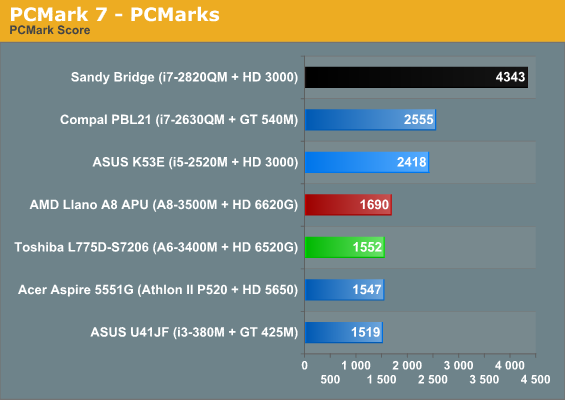
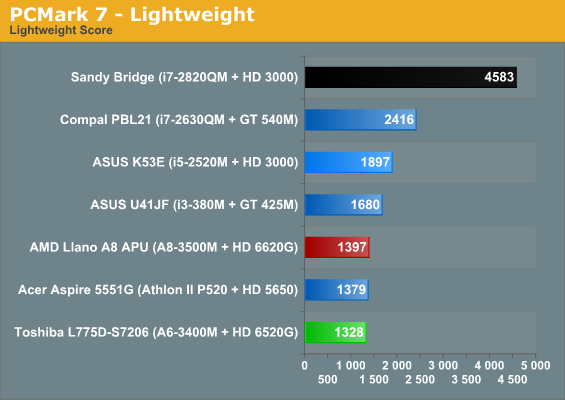
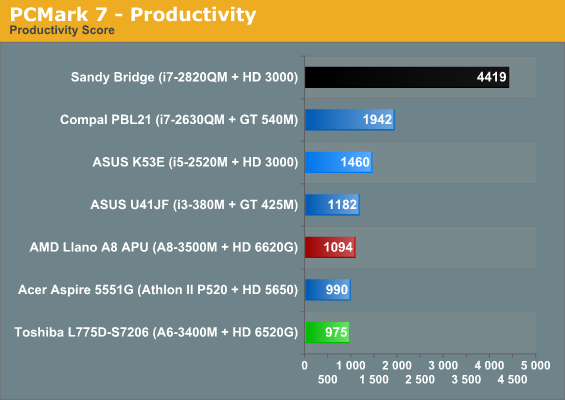
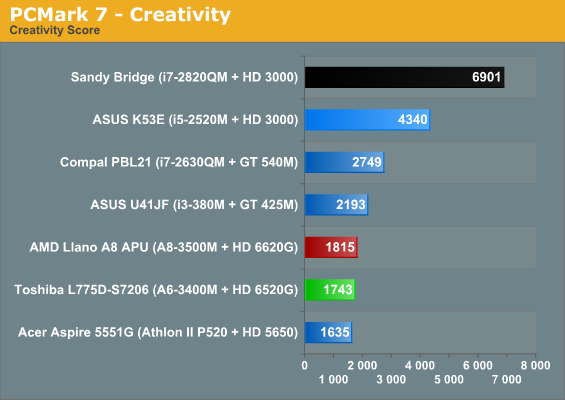
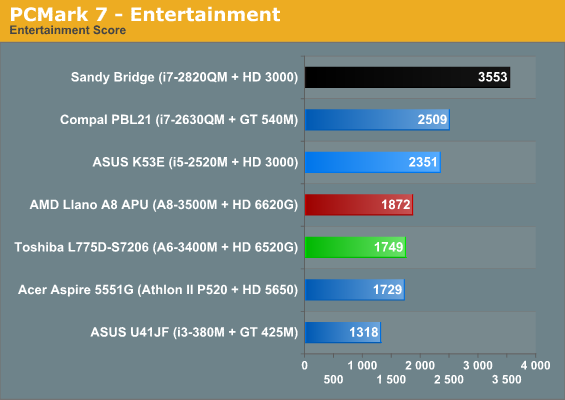

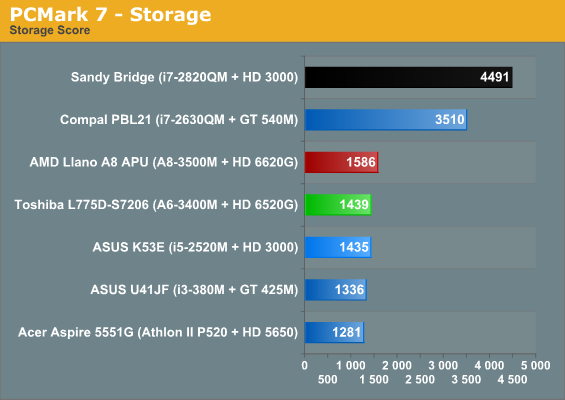
You can see in PCMark 7 that Sandy Bridge pretty much dusts the A6-3400M (noting that the quad-core Sandy Bridge test systems do benefit from SSDs), and it basically trades blows with Arrandale. The dual-core i5-2520M with an HDD is in the ASUS K53E, and outside of the storage test it also pummels Llano. What's particularly interesting, though, is that the A6-3400M is barely slower than the A8-3500M, at least in these synthetic tests. That makes sense: only 100MHz separates the two processors, but at least as far as the CPU goes you can make that sacrifice fairly comfortably since the A8 is much more rarefied in the wild than the A6. The Athlon II P520, meanwhile, boasts two cores at a nominal 2.3GHz and trades blows with the new Llano chips.

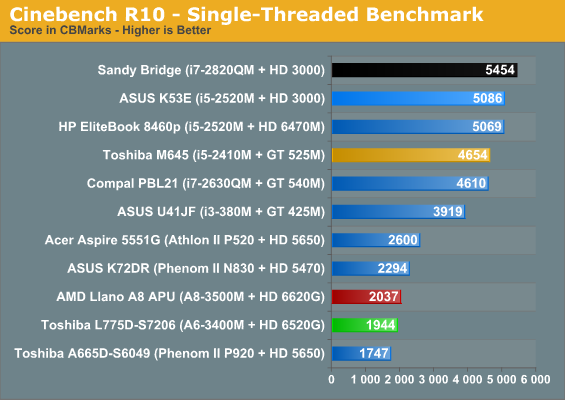
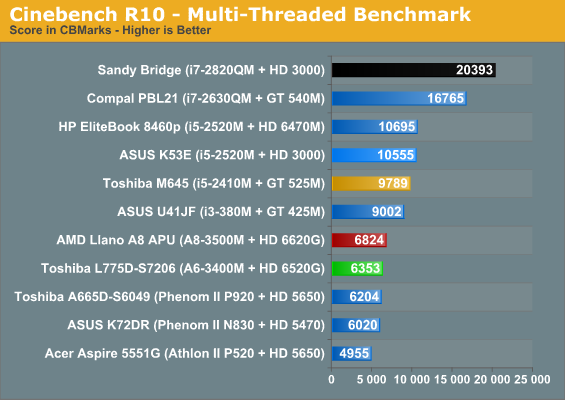
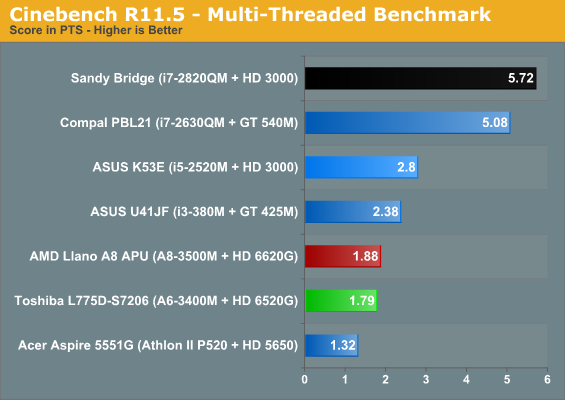
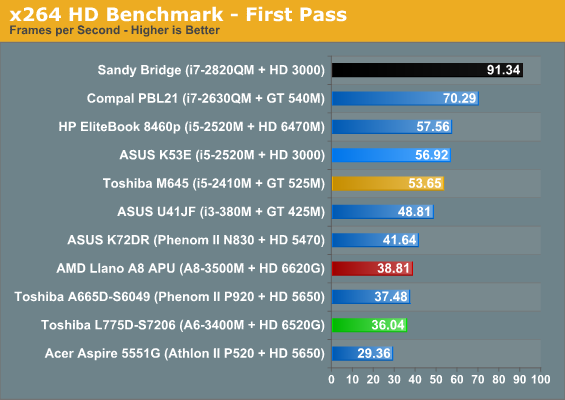
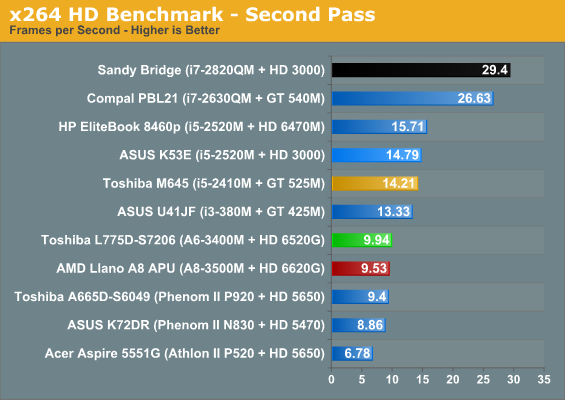
There's an awful lot to digest here. First, two of Intel's Hyper-Threaded cores running at a high clock speed basically run roughshod over four slow Stars cores: no surprsies there. But the Phenom II P920 in the Toshiba A665D-S6049 is a 1.5GHz quad core with 512KB of L2 cache per core instead of 1MB as in Llano, though the cores are otherwise almost identical. In most cases the AMD chips bunch together while the Intel chips gum up the top of the chart. The takeaway is brutal, though: Trinity, with its Bulldozer cores instead of Stars cores, can't get here fast enough. The i7-2820QM in our Sandy Bridge testbed is nearly three times faster than Llano, and the i5-2520M is about 60% faster on average.


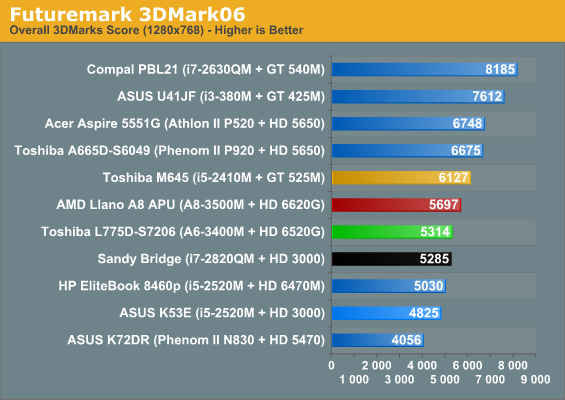
Things brighten up a bit when we get to 3DMark, where Llano's modified Redwood GPU core is able to hang fairly well with discrete-class GPUs. The A6-3400M may be closer to the bottom of the charts in each case, but it's still producing impressive performance compared to the string of dedicated graphics parts. It's easy to understand why AMD's PR splits hairs about calling Llano's graphics core an IGP and prefer to call it an "iGPU" or Fusion GPU, because while it's an IGP in the strictest sense, it doesn't necessarily deserve the negative connotations that have stigmatized the term as a result of Intel's pre-Sandy Bridge integrated graphics parts. Also worth pointing out in case you missed it is the lack of 3DMark11 results for any of the Intel IGPs; as a test that requires DX11, even Sandy Bridge can't run it without a dedicated GPU.










74 Comments
View All Comments
Rookierookie - Friday, August 12, 2011 - link
Pricing this at $699 brings this into competition with the Dell XPS 15, which starts at $799 with i5-2410M and a Nvidia GT 525M. You trade off on some utilities, but it's basically a much faster laptop for about $100 more.At $599 this becomes a much more attractive option.
nitrousoxide - Friday, August 12, 2011 - link
No, for that $100 you can get an SSD. And it feels "much faster" than the XPS 15 with HDD.prdola0 - Friday, August 12, 2011 - link
SSD with usable size for $100? No. Not really. XPS 15 is a much better choice.JGabriel - Friday, August 12, 2011 - link
Dustin Sklavos @ Top: "I do honestly think two faster AMD cores would've been a better call than four slow cores"
For low-end home users, the most common problem I've seen is thread clutter. We're talking about people who aren't very tech literate, and load up their machines with tons of little tech gewgaws to tell them the weather, list headlines, perform animations when they get mail, make their mouse cursor "cute", and so on.
I suspect this is one of AMD's target markets for Llano. If so, one can see the argument in favor of more slow cores over few fewer fast ones. These are people who don't need to get anything done quickly, they just need a lot of low-demand things done simultaneously.
jfelano - Monday, August 15, 2011 - link
It will be $599ckryan - Friday, August 12, 2011 - link
The contrast ratio chart shows that laptop screens are usually not very good. Not that its newsworthy, but how do manufacturers expect to keep selling even midrange laptops when you can get a tablet with a bitchin screen and better battery life. Not that the two devices roles are interchangeable for many tasks, but I for one won't be buying another laptop until screens get better.damianrobertjones - Friday, August 12, 2011 - link
It is a shame that the Radiance (HP Envy line) screen maker went out of business! madnessLordConrad - Friday, August 12, 2011 - link
As someone who wears glasses, I personally like my screens with a slightly lower resolution because everything is natively larger. I know you can adjust font and icon sizes in Windows, or simply change the resolution, but I consider these changes to be a last resort option. I loved my last HP dv7 laptop, it was a bit bulky but it had a beautiful 1440x900 screen that was just right for my eyesight. My current laptop is a slightly smaller and less bulky dv6 with a 1366x768 screen, which is also perfect for my eyesight. With both laptops I had the option to get a higher resolution screen, which they probably don't include on the review systems you get.Just keep in mind that not everyone has 20/20 (or better) vision.
Dustin Sklavos - Friday, August 12, 2011 - link
Actually my eyesight is pretty dire, too.The thing is, high resolution screens seem to tend to produce better color, better contrast, and better viewing angles. I'd take one of those at a lower-than-native resolution at this point, just because they LOOK better.
ckryan - Friday, August 12, 2011 - link
My eyesight is pretty good, and I no longer prefer maximum DPI. A 1920X1200 display is great at 24", but in a 15" laptop it's definitely not for everyone. I told a family member not to get one as an upgrade in a Dell Vostro a couple years ago; She runs it at half the native resolution. It is a pretty good TN screen, much better than the other options, but just way to fine pitched. I'm to the point where I will happily take a better panel display at a lower res than a much higher TN panel. It would be different if WIndows was better about scaling, but you can only do so much by adjusting DPI display settings.Still, I'm pretty serious about not buying another laptop until I can get a display in the style to which I'm accustomed these days. Whenever I pick up my laptop I die a little on the inside. The viewing angles are terrible, black level is absurdly high, contrast is low, and this is the upgraded panel in the Dell D630 14" I'm using. At least I have the docking bay for it.